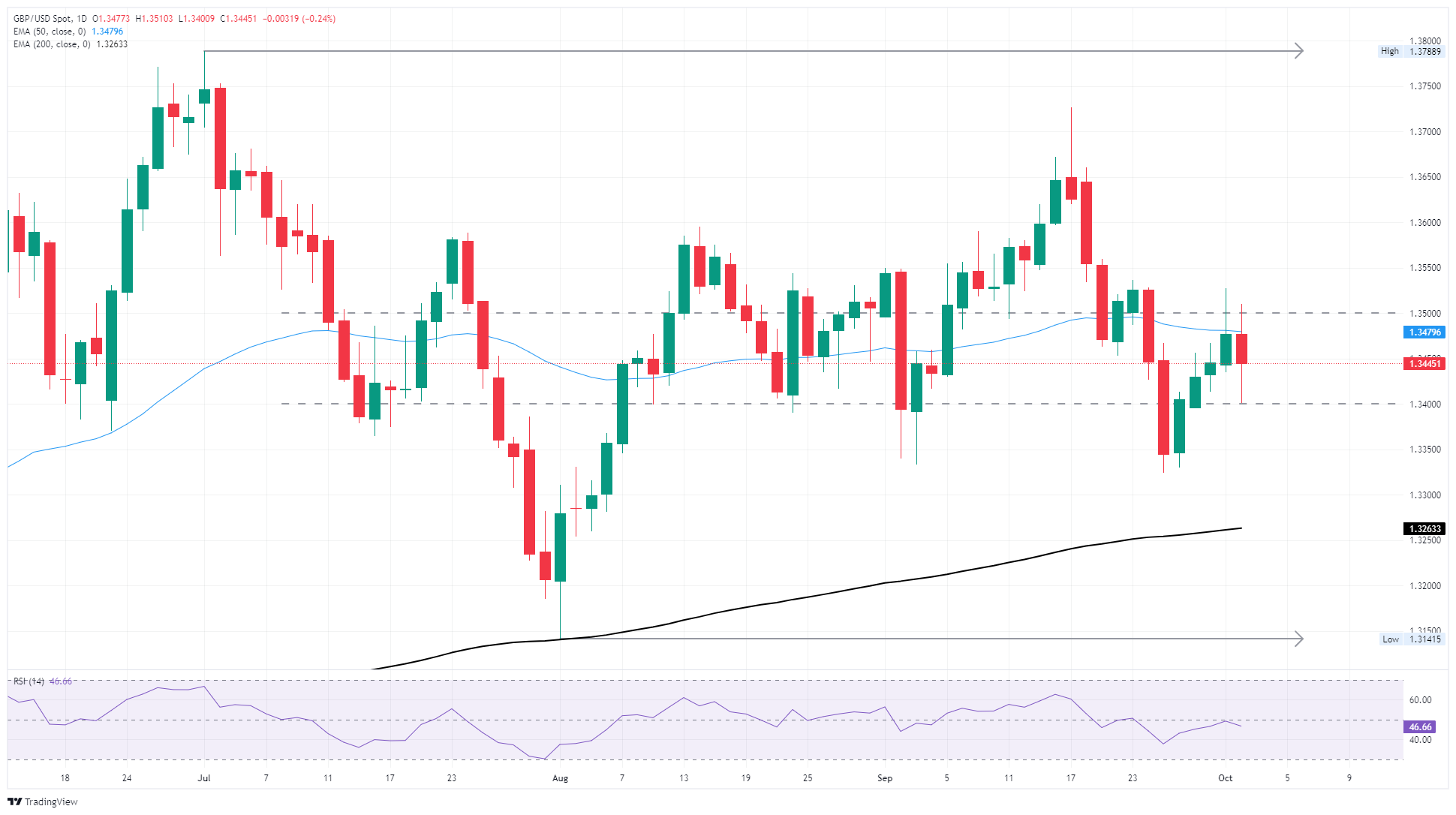GBP/USD snaps winning streak but remains in consolidation
- GBP/USD fumbled a bullish run for the 1.3500 handle.
- Despite getting knocked back, Cable is still cycling familiar chart territory.
- Market flows remain largely on-balance despite the potential suspension of key NFP data on Friday.
GBP/USD backslid on Thursday, snapping a four-session winning streak and tumbling back from a technical rejection at the 1.3500 handle. Cable is drifting back into medium-term consolidation from 1.3400 to 1.3500 and price action is holding stubbornly just below the 50-day Exponential Moving Average. Markets are taking an extended pause in momentum as investors weigh how long the US government’s federal shutdown will last, and what the economic impacts could be.
The UK side of the economic data docket is devoid of any meaningful releases on Friday, leaving investors to grapple with sentiment about missing the latest US Nonfarm Payrolls (NFP) labor figures. Investors are banking on the latest government shutdown having a limited impact on economic factors. Traders largely expect this closure to be short-lived, and overall market focus remains pinned firmly on Federal Reserve (Fed) interest rate cuts through the remainder of the calendar year.
According to the CME’s FedWatch Tool, rate markets have fully priced in a follow-up interest rate cut on October 29, with over 90% odds of getting a third straight rate trim on December 10. Rate traders are also expecting the Fed to deliver a fourth quarter-point rate cut in either March or April of next year.
According to various sources, the latest NFP jobs report is ready to be released, but BLS operational guidelines mean labor data will be withheld during a government shutdown. The latest weekly Initial Jobless Claims data was not reported this week, despite being collected and compiled prior to the government shutdown. Unless the Trump administration specifically moves to publish the latest jobs figures, this week’s NFP print will remain in limbo pending the return of the US government.
GBP/USD daily chart

Pound Sterling FAQs
The Pound Sterling (GBP) is the oldest currency in the world (886 AD) and the official currency of the United Kingdom. It is the fourth most traded unit for foreign exchange (FX) in the world, accounting for 12% of all transactions, averaging $630 billion a day, according to 2022 data. Its key trading pairs are GBP/USD, also known as ‘Cable’, which accounts for 11% of FX, GBP/JPY, or the ‘Dragon’ as it is known by traders (3%), and EUR/GBP (2%). The Pound Sterling is issued by the Bank of England (BoE).
The single most important factor influencing the value of the Pound Sterling is monetary policy decided by the Bank of England. The BoE bases its decisions on whether it has achieved its primary goal of “price stability” – a steady inflation rate of around 2%. Its primary tool for achieving this is the adjustment of interest rates. When inflation is too high, the BoE will try to rein it in by raising interest rates, making it more expensive for people and businesses to access credit. This is generally positive for GBP, as higher interest rates make the UK a more attractive place for global investors to park their money. When inflation falls too low it is a sign economic growth is slowing. In this scenario, the BoE will consider lowering interest rates to cheapen credit so businesses will borrow more to invest in growth-generating projects.
Data releases gauge the health of the economy and can impact the value of the Pound Sterling. Indicators such as GDP, Manufacturing and Services PMIs, and employment can all influence the direction of the GBP. A strong economy is good for Sterling. Not only does it attract more foreign investment but it may encourage the BoE to put up interest rates, which will directly strengthen GBP. Otherwise, if economic data is weak, the Pound Sterling is likely to fall.
Another significant data release for the Pound Sterling is the Trade Balance. This indicator measures the difference between what a country earns from its exports and what it spends on imports over a given period. If a country produces highly sought-after exports, its currency will benefit purely from the extra demand created from foreign buyers seeking to purchase these goods. Therefore, a positive net Trade Balance strengthens a currency and vice versa for a negative balance.

